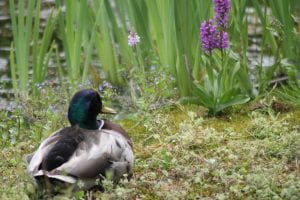By Andy Winfield
 As I always say, I love water, I couldn’t live without it… pause for laughter…🤦 Water is a life giver; in its primordial soup days it was the catalyst for all organisms. Deep down I think we all, one way or the other, have a fascination with bodies of water, from the biggest ocean or lake to a small rockpool or garden pond, we all can while away time watching the world within a world. Our Botanic Garden pool is no different, a captivating show full of skilled performers at the top of their game.
As I always say, I love water, I couldn’t live without it… pause for laughter…🤦 Water is a life giver; in its primordial soup days it was the catalyst for all organisms. Deep down I think we all, one way or the other, have a fascination with bodies of water, from the biggest ocean or lake to a small rockpool or garden pond, we all can while away time watching the world within a world. Our Botanic Garden pool is no different, a captivating show full of skilled performers at the top of their game.
When we first arrived at the Holmes to build the Garden, the area where the pool is now was a lawn. I clearly remember marking out where the pool was going to be with a measuring wheel and paint. It was dug, lined with sand, an underlay, and a huge single butyl membrane was rolled out; a small amount of tap water went in the bottom to settle the liner, and then we left it for the sky to fill with its precipitation of choice.
This was 2006, and now, fifteen years later, the pool is alive. We planted five pots of water lilies and some bogbean; everything else you see has travelled via ducks, wind or rain. Iris rise sword-like from the water; bulrushes, the furry microphone of the plant world; while under the water the leaves of Canadian pondweed feed, no need for roots, and release oxygen, keeping the pool algae free as well as  providing shelter for small predators and prey alike.
providing shelter for small predators and prey alike.
As plant life arrived in the water, around the edge of the pool we had a problem; the liner was exposed to sunlight and weather above the tideline, and we were worried it would perish. We tried a few things. Firstly, coir matting bridged the gap which was a wonderful moment for all the local wildlife. We saw squirrels bundling it under their chins, birds with beaks full, and at night the badgers must have been rolling it back to their sets; the comfort of that winter must be legendary for the local animal population and the coir lasted about a month by the pool. We tried mud which washed off. In the end, we bought a few rolls of fake grass and dug it in around the pool, sand was thrown on it to stop it floating to the surface and it worked. Today, this fake grass is covered in moss, ferns and, believe it or not, Marsh and Common Spotted Orchids. We’re not sure why this is a perfect growing medium for notoriously fussy plants, but we  can have an educated guess at it. Orchids tend to like low nutrient shallow soil and the soil on top of the fake grass is certainly shallow and there will be few nutrients available lower down. The orchids are a great sight each year, but we’re not encouraging anyone to replace living plants with fake grass!
can have an educated guess at it. Orchids tend to like low nutrient shallow soil and the soil on top of the fake grass is certainly shallow and there will be few nutrients available lower down. The orchids are a great sight each year, but we’re not encouraging anyone to replace living plants with fake grass!
This is just the plants; the water is teeming with insects and amphibians; newts gracefully swimming to the surface for air while water boatmen row around them and pond skaters circle above; birds washing in the margins from crows, ravens and blackbirds to sparrow hawks, peregrine falcons and herons; one special morning a kingfisher arrived and scoped out the area for a potential meal before realising there were no fish, and it was better off elsewhere. The dragonflies have recently hit the scene leaving the shells of their larval stage hanging off stems; their aeronautical displays are mesmerising, zigzagging across the water in their aviator shades.
Peering in water and watching another world within a world is one of life’s pleasures, a way to lose yourself for a moment.


